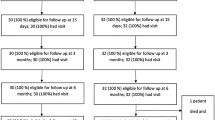Abstract
Use of mosquito net, in place of polypropylene mesh, had been reported for tension-free hernia repair, as a better cost-effective option. This experimental histopathological study was performed in rats to find out the tissue response and the foreign body reaction and its comparison between commercial polypropylene mesh and the sterilized mosquito net. This experimental study was conducted in the Department of Surgery, Government NSCB, Medical College, Jabalpur (Madhya Pradesh), India. It was carried out in 40 albino rats. A 1.5 × 0.5-cm hernial defect was created by excising full-thickness abdominal wall muscle. All rats underwent on-lay mesh repair of hernial defect (polypropylene mesh, n = 20; mosquito net, n = 20). Half of rats in each group were sacrificed on day 14, and the other half, on day 90. Sections of containing mesh were examined histopathologically for inflammatory infiltrate, giant cells, and collagen deposition. Mosquito net group showed significantly greater number of giant cells and inflammatory cells at 14 and 90 days (p < 0.0001, p < 0.001, p < 0.05, and p < 0.001, respectively), as compared to polypropylene group. Grades of collagen fiber deposition were almost equal in both groups, both at 14 and 90 days (p > 0.05 and p > 0.05, respectively). Results of mosquito net are comparable to conventional polypropylene mesh. In a setup, where cost-effectiveness is of primary importance, use of mosquito net for tension-free hernia repair can be an acceptable alternative as proven histologically, to commercially available polypropylene mesh.

Similar content being viewed by others
References
Lichtenstein IL, Shulman AG, Amid PK, Montllor MM (1989) The tension-free hernioplasty. Am J Surg 157(2):188–193
Tongaonkar RR, Reddy BV, Mehta VK, Singh NS, Shivade S (2003) Preliminary multicentric trial of cheap indigenous mosquito-net cloth for tension-free hernia repair. Ind J Surg 65(1):89–95
Freudenberg S, Sano D, Ouangré E, Weiss C, Wilhelm TJ (2006) Commercial mesh versus nylon mosquito net for hernia repair. A randomized double-blind study in Burkina Faso. World J Surg 30(10):1784–1789
Clarke MG, Oppong C, Simmermacher R, Park K, Kurzer M, Vanotoo L, Kingsnorth AN (2009) The use of sterilised polyester mosquito net mesh for inguinal hernia repair in Ghana. Hernia 13(2):155–159
Shillcutt SD, Clarke MG, Kingsnorth AN (2010) Cost-effectiveness of groin hernia surgery in the Western Region of Ghana. Arch Surg 145(10):954–961
Yang J, Papandria D, Rhee D, Perry H, Abdullah F (2011) Low-cost mesh for inguinal hernia repair in resource-limited settings. Hernia 15(5):485–489
Shah SR, Abhayankar AB, Mathur SK (1996) Mesh laparostomy—a comparison between polypropylene mesh and indigenous nylon net. Trop Gastroenterol 17(2):49–54
Hodges AM (2001) Fishing line: a valuable suture material. Trop Doct 31:98–99
Misra MC, Kumar S, Bansal VK (2008) Total extraperitoneal (TEP) mesh repair of inguinal hernia in the developing world: comparison of low-cost indigenous balloon dissection versus direct telescopic dissection: a prospective randomized controlled study. Surg Endosc 22(9):1947–1958
Parulkar BG, Mathur SK, Supe AN, Samsi AB, Vora IM (1986) Use of indigenous knitted nylon mesh to repair large abdominal defects—an experimental study. J Postgrad Med 32(4):214–218
Wilhelm TJ, Freudenberg S, Jonas E, Grobholz R, Post S, Kyamanywa P (2007) Sterilized mosquito net versus commercial mesh for hernia repair. An experimental study in goats in Mbarara/Uganda. Eur Surg Res 39(5):312–317
Champault G, Bernard C, Rizk N, Polliand C (2007) Inguinal hernia repair: the choice of prosthesis outweighs that of technique. Hernia 11(2):125–128
Paajanen H (2007) A single-surgeon randomized trial comparing three composite meshes on chronic pain after Lichtenstein hernia repair in local anesthesia. Hernia 11(4):335–339
Markar SR, Karthikesalingam A, Alam F, Tang TY, Walsh SR, Sadat U (2010) Partially or completely absorbable versus nonabsorbable mesh repair for inguinal hernia: a systematic review and meta-analysis. Surg Laparosc Endosc Percutan Tech 20(4):213–219
Sanders DL, Kingsnorth AN, Stephenson BM (2013) Mosquito net mesh for abdominal wall hernioplasty: a comparison of material characteristics with commercial prosthetics. World J Surg 37(4):737–745
Stephenson BM, Kingsnorth AN (2011) Safety and sterilization of mosquito net mesh for humanitarian inguinal hernioplasty. World J Surg 35(9):1957–1960
Sørensen CG, Rosenberg J (2012) The use of sterilized mosquito nets for hernioplasty: a systematic review. Hernia 16(6):621–625
Simmons D (2008) The use of animal models in studying genetic disease: transgenesis and induced mutation. Nat Educ 1(1)
Acknowledgments
We give thanks to Dr. B. Reddy for providing sterilized mosquito net.
Author information
Authors and Affiliations
Corresponding author
Rights and permissions
About this article
Cite this article
Sharma, M., Sharma, D.B., Chandrakar, S.K. et al. Histopathological Comparison of Mosquito Net with Polypropylene Mesh for Hernia Repair: An Experimental Study in Rats. Indian J Surg 77 (Suppl 2), 511–514 (2015). https://doi.org/10.1007/s12262-013-0904-6
Received:
Accepted:
Published:
Issue Date:
DOI: https://doi.org/10.1007/s12262-013-0904-6




